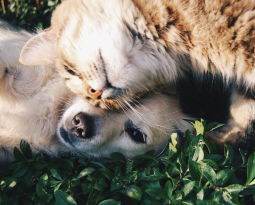This year pet adoptions have been skyrocketing! With so many people working from home and spending more time at home, they’ve been bringing new furry family home with them. It’s also nearing the winter holidays, another time when new pet ownership tends to spike. All of that is great, we love hearing about new furry friends finding new homes. But what happens when the new cat doesn’t get along with the others? Or a new pup seems almost aggressively playful with the older dog?
This month on the Acoma Animal Clinic blog we’re focusing on easing the transition when you introduce a new pet to your home! Whether you’re bringing a new cat into a home with an existing cat or a dog, or a new dog into a home with another dog or cats, you need to go about things the right way. And that is different for every situation! Dogs and cats, in general, have vastly different approaches to letting in new members to their cliques.
To that end, we’ll be posting two more blogs later this month, one that is focused on introducing a new cat to your home and another focused on introducing a new dog. Hopefully taken together, and with proper care and effort, you’ll be able to bring any new pet into your home in a way that’s comfortable, safe, and happy for everyone!
For all pets, regardless of species, remember a couple of things.
Don’t Let Them Have the Run of the House
Many pets coming from a shelter have been in a kennel or cage for days or even weeks before they get to your door. To go from that to all of the space in your home might seem freeing at first, but it can actually be incredibly overwhelming for the animal. Resist that temptation to let them run wild in your home during the first week or so – and that’s especially crucial if you have other pets!
Dogs
For dogs, give the new pup about a week at minimum to settle in and start to feel comfortable with the surroundings. When they seem comfortable and relaxed, meaning they aren’t hiding and are willing to come to you for food and attention, you can start to open up access to other areas of the house.
Give your new dog a week or more to settle in and feel comfortable with her new environment. If your new puppy or dog seems comfortable and relaxed (not hiding and is willing to come to you for affection and food) you can provide access to other areas of your home.
Cats
Cats are different, of course. They are much more likely to be creatures of habit than dogs, meaning they’ll be happy to hide under a bed or stay in a closet for days. When this happens, don’t force any interactions. Create a small, quiet area for the new cat to become acclimated and establish a safe place.
As said, cats are more likely to be creatures of habit, meaning they’ll easily need a week or more to feel comfortable with a new environment so it’s best to create a single, quiet room with everything they need. Their litterbox, food dish, bed.
When they seem comfortable, meaning they’re no longer hiding and willing to come to you for food and attention, and if they are the only pet you can than open up other areas of your home.
Motivating and encouraging cats to explore and become acclimated can be difficult at first.
When you’re ready, simply open the door from your cat’s room and sit outside it. Encourage them to come out and reward them with a treat and attention when they do so. Stay where ou are and let the cat begin to wander freely. If they seem fine, after about 15 minutes you can get up and go about your day. Do stay close to keep an eye on and make sure they don’t get into trouble.
Restrict the free time in the beginning, to make the experience and acclimation more manageable for the new pet. Once they have begun to find new places to rest, play, and relax, move their food, litter, etc. to their permanent locations.
If there are places your pets are not allowed to go, be they tabletops, cabinets, into certain rooms, whatever, make sure you establish those rules early and regularly. If the cats first interaction with a counter is that they aren’t supposed to go up there, they are more likely to recognize it.
Some animals respond really well to having this expanded living space, but others don’t! Some are frightened and retreat. If they seem more nervous with more access, slow down the process to better fit their comfort. Some dogs feel the safest in small areas, while others want to roam free. It’s the same with cats.
Pay close attention to your pet to better understand what they prefer, and meet them there. If you’re bringing a new dog or cat into the home with another pet already there, you’ll want to check back next time where we go into more specific animal to animal advice.







